This test report was presented to us from Endruo Bearings. It’s the culmination of a project they have been working on for almost two years. The information includes test protocols and results for Enduro bottom bracket bearings and other brands. It looks at bearing wear and tear due to multi-directional loads endured during cycling, which is just one cause of bearing degradation and failure. It’s a lot to chew on (and long-winded), but it’s fascinating as it pertains to something we all have experienced; rough, noisy, and worn-out bearings in our bottom brackets while riding.
A History of Problem-Solving
Founded in 1996, Enduro Bearings has designed and manufactured bicycle bearings for nearly 30 years. Co-founder, Matt Harvey, leads the company’s cycling division. Matt has a Bachelor’s degree in Mechanical Design and previously worked in product management and development at White Industries, Gary Fisher Mountain Bikes, and Bianchi.
In 1997, Enduro introduced its first bearing innovation: MAX full-compliment suspension pivot bearings, now widely considered as the industry standard. Enduro continues to innovate and expand its offerings to include over 1,000 hubs, headsets, bottom brackets, derailleur pulley bearings, and components. The company invented Torqtite, which inspired dozens of thread-together solutions for noisemaking, press-fit bottom brackets. Twelve years ago, Enduro developed the first of two “forever” products, XD15 ceramic-hybrid bicycle bearings. In 2021, a second-lifetime warranty product hit the market: the patented, all-440C stainless Maxhit headsets and bottom brackets. Enduro Bearings is now a global enterprise that supplies hundreds of OEM manufacturers and thousands of retailers worldwide. Millions of cyclists pedal bikes with Enduro Bearings inside.
Modern Bottom Bracket Bearing Failures & Fixes
In the late 1990s, industry leader Shimano introduced larger diameter 22mm hollow, splined crankset spindles in the interest of improved pedaling efficiency. Unfortunately, the bottom bracket shell’s inner diameter held tight at 35mm – a specification introduced in the 1800s to accommodate smaller 17mm square taper spindles.
Competitive drivetrain manufacturers countered Shimano with an industry-wide adoption of the ISIS (International Splined Interface Standard) BB System, which also utilized a 22mm (or 21.5mm) spindle. With less’ bearing space’ available in the 35mm BB shell (drawing to the left), fragile bearings with thin races and significantly smaller 2 mm-2.5 mm bearing balls were specified.
Soon after introduction, ISIS and Shimano bottom bracket bearings began failing quickly and in large numbers. This is when Matt Harvey had an idea and went to work.
Building the Test Machine
An improved ISIS-bearing solution had to be developed quickly, requiring test equipment to shorten the R&D timeline dramatically. Matt Harvey soon realized that cycling-specific test equipment did not exist, so he designed and built a bike-bearing test machine. Within a few months, Max Tester, the bearing test machine, successfully simulated the high radial and axial loads with rotational speeds typical to bicycle bottom bracket bearings. This drastically reduced the analysis time from many months of field testing to a couple of weeks of amplified lab testing.
Soon after, Enduro Bearings designed, tested, and introduced a unique ISIS-compatible double-row radial bearing with durability equal to 17mm square taper spindle designs. By the mid-2000s, the market abandoned the ISIS BB standard in favor of an outboard bearing design that reintroduced larger ball bearings with thicker races to support the crankset better.
As the cycling industry continued developing bottom bracket variants, Enduro has rapidly responded with reliable, efficient, longer-lasting bearing solutions using superior steels and ceramics, larger ball diameters, and deeper groove races. One of many examples is the invention of MR 2437 bearings to improve on Shimano’s outboard 6805 bearings with the “plastic top hat.”
Enduro refreshed and upgraded Max Tester with three data measuring devices before the bottom bracket bearing test shared herein. Not only can the machine comparatively test bearings for longevity and failure, but Enduro’s test machine can also now measure bearing efficiency over time through wattage as well as detect bearing wear and deterioration through vibration testing.
Vibration testing is common practice in aviation, automotive, and other industries. A new smooth bearing exhibits a reading of 0.5 – 0.8 mm/second (including test machine interference). Vibration readings will double or triple when a bearing begins to deteriorate, usually triggered by internal race galling. A reading in excess of 2 mm/second is an early warning for total bearing failure.
Max Tester II: Adding Energy (Watts) and Vibration Tracking to Multi-Direction Load Testing
Enduro refreshed and upgraded Max Tester with three data measuring devices before the bottom bracket bearing test shared herein. Not only can the machine comparatively test bearings for longevity and failure, but Enduro’s test machine can also now measure bearing efficiency over time through wattage as well as detect bearing wear and deterioration through vibration testing.
Vibration testing is common practice in aviation, automotive, and other industries. A new smooth bearing exhibits a reading of 0.5 – 0.8 mm/second (including test machine interference). Vibration readings will double or triple when a bearing begins to deteriorate, usually triggered by internal race galling. A reading in excess of 2 mm/second is an early warning for total bearing failure.
- Energy (watts) data for each bottom bracket tested are included towards the end of this post.
- Vibration data are not included, as the resonance meter was recently added. However, the early data indicates that wattage numbers also increase as vibration increases.
Watts in the Real World
Ball bearings are highly efficient with a very low coefficient of friction. There are many enhanced claims regarding bearing efficiency and watts saved in cycling. In reality, a new well-made bottom bracket bearing assembly only uses one-half watt, and a low-quality assembly doubles drag to one full watt. The chain at approximately five watts is the most considerable wattage drain in a clean drivetrain.
Amplified Testing: Larger Loads Speed-up Testing and Improve Accuracy
To gather precise, accurate data, amplifying test parameters are standard practice in aviation, automotive, and many other industries. In normal cycling conditions, a pro athlete weighs 68 kg. / 150 lbs. is loading and unloading a pair of radial bottom bracket bearings at 100 RPM and averaging 250 watts. Enduro’s test protocol involves just one bottom bracket bearing at nearly twice the power input and three times the weight. Short testing times are indeed beneficial. Another benefit of amplified testing is consistently collecting data within a power meter’s ‘measurable zone.’ For example, commercially available watt power meters cannot detect differences of less than one watt.
Field Testing versus Machine Testing: both matter
In 2011, after an in-house machine and a shorter duration of field testing, Enduro introduced the world’s first XD15 ceramic-hybrid bottom bracket bearing and set out to prove that its bearing design philosophy and use of superior materials would result in a “forever” bicycle bearing.
The most valid testing is long-term on bikes in the real world, which can take years to complete. In 2011, we installed XD15 bottom brackets on a handful of professional riders’ bikes – with no failures. One field tester, a former professional on the Webcor Cycling Team, still rides mega miles in all types of weather on a 2011 race bike with the same XD15 BB. With 60k miles in the books, his XD15 bottom bracket has never been serviced.
The most surprising XD15 test report was possibly written by James Huang for Bike Radar in 2013. After a year-plus of purposeful abuse, James stated, “As if that weren’t demanding enough, we ran the entirety of the test with all of the seals removed. Even though we could readily see the fully exposed, naked ball bearings, the XD15 merely laughed it off, spinning as smoothly after months of intentional abuse as it did when new, even with no lubricant whatsoever aside from pulverized sand and grit.”
2021-23 Amplified Bottom Bracket Bearing Fatigue & Efficiency Test
Fast forward to 2021, and déjà vu all over again. Spindle diameters have increased from 22mm to 24mm, 29mm, and 30mm, prompting bearing and component manufacturers to revert to the same small ball sizes found in the failure-prone ISIS System.
Needing to test its promising yet unproven all-440C, Maxhit integrated assembly bottom brackets, Enduro developed the following protocols for an amplified bottom bracket fatigue test.
Test Overview & Protocols
After 15-plus years of comparing various machine testing protocols and results with real-world bicycle bearing deterioration timelines and failures, Matt Harvey determined the following machine testing methods to be the most appropriate and accurate for Enduro Bearings product development.
This test began in September 2021 and concluded in March 2023. Testing hours were Monday through Friday, 9 am to 5 pm. All testing was supervised by Matt Harvey, either in person or via video recording. The test machine resides in a closed, temperature-controlled room. All test bearings were stored in a clean but not sterile environment between test sessions.
All test hours were run at 100 RPM or 6,000 cycles per hour. After the warm-up period described below, a 30mm “Cinch” Power Meter spindle is mated to the test machine shaft for gathering loaded bearing watt measurements at the intervals shared in the results chart on page four. In every instance, one bottom bracket bearing (not two) rotated under 82 kg./180 lbs. radial and 27 kg./60 lbs. thrust loads for a total axial load of 109 kg./240 lbs. This equates to 218 kg./480 lbs. rider pushing a consistent 600 power watts.
The test did not include sinusoidal testing with varying forces, and constant pressure was applied as the ball bearings were spinning and loaded in either scenario. As in the aviation industry, amplifying a test and overstressing the bearing is a standard procedure to produce more consistent and measurable results.
Warm-up Period
Without a bottom bracket attached and zero loads applied, the DC electric watt meter attached to the test machine shaft read 2-3 watts. With a new bottom bracket test bearing installed onto the test machine shaft and under light axial load, the shaft reading increased to 3-4 watts. After a twenty-minute warm-up, all new test bearings, without exception, measured a stable 3 watts at the test machine shaft.
Bearing Test Data Acquisition
With test protocols established, in every instance for each test bearing and at every data capture interval, the following steps were repeated:
- Test bearings and room temperature were warmed to 20C / 68F.
- A 2-hour test machine warm-up period was honored.
- The DC electric and Cinch power meter wattage were stabilized at 2 watts each.
- Test bearings rotated at 100 RPM for 20 minutes under light radial and thrust loads.
- Test bearings were fully loaded, rotating at 100 RPM for 10 minutes prior to capturing the data.
Test Mules: 4 Enduro & 6 Competitor BB Bearing Assemblies
An assembly is defined as the outer, splined aluminum cup with a bottom bracket bearing pressed-in or an integrated bearing assembly such as Enduro Maxhit. The test included two unaltered samples of each bearing assembly, ordered from a bicycle parts and accessories distributor in original packaging. Testing multiple samples would require many years rather than 18 months.
Test Results & Observations
- All bearings initially performed slightly better after a ‘seals and grease’ break-in period.
- After the break-in period, depending on the seal design and the amount of grease fill, all bearings performed equally well, averaging 10 to 11 amplified watts for the first 30 test hours.
- Soon after wattage numbers increased, bearings became noisy under machine load. They would spin roughly with more resistance in your hand, indicating spalling to galling deterioration.
- The results chart offers additional insights, including how corrosion impacts.
Conclusions
-
- Bearing assemblies with fewer, larger bearing balls perform better and last longer than bearing assemblies with smaller bearing balls in greater numbers.
- In all cases, the matching of larger diameter bearing balls with deep groove bearing races produced desired improvements in efficiency (watts) and durability (cycles). At a given RPM, larger balls roll slower than the smaller balls, half the speed in some bearing sizes. Fewer, larger balls spread the load better due to an aggregate contact patch area that is greater than the aggregate contact patch provided by smaller balls in greater numbers. This effect is called the Hertzian force. Compared to the other models using industry-standard bearings with smaller balls and shallower races, less energy or wattage was needed to rotate Maxhit and XD15 bearings under load.
- Hertzian forces, in this case, are the reaction of a bearing ball meeting a bearing race under load resulting in a wave. As the balls roll along the race groove, at a micro level, the ball deforms the bearing race, causing a wave in front of the rotating ball. Fewer larger balls mitigate this reaction as their combined surface contact patch is larger than smaller balls in greater numbers. This translates to less power required to spin at a given RPM and a longer bearing life.
- Bearing designs that harmonize material choices last longer. When combined in a bearing assembly, materials that perform well independently can lead to premature bearing wear and failure.
- Combining premium quality ceramic balls with a Nitrogen-infused stainless steel bearing race outperformed quality ceramic balls rolling in chromium steel bearing races in both key measures: rolling efficiency and longevity.
- 440C Stainless Steel is known for its corrosion resistance, resiliency, and relative softness. Under load, this metal is prone to premature wear when paired with smaller 440C bearing balls. When paired with larger 440C bearing balls, efficiency, and durability improve dramatically.
- Only the bearing designs that combine the attributes of conclusions #1 and #2 completed 3,000,000 cycles as good as or better than new. Some other models tested began to deteriorate at 150,000 cycles, with all models losing efficiency no later than 360,000 cycles.
- Optimizing bicycle bearing design for performance and durability is not one thing but many things. It requires a thorough understanding of multi-directional cycling loads, application-specific material choices (balls, races, seals, and grease), manufacturing rigor, and quality control.
- Bearing assemblies with fewer, larger bearing balls perform better and last longer than bearing assemblies with smaller bearing balls in greater numbers.
Enduro Product Solutions
Beginning in 1997 with MAX suspension bearings, Enduro bicycle bearings have included larger bearing balls nested in deep grooves. XD15 bottom brackets use 4mm ceramic bearing balls, and Maxhit BBs use 5mm 440C stainless balls. Both are much larger than industry standards (2, 2.5, and 3mm), greatly reducing Hertzian force to improve bearing performance.
XD15
Enduro’s industry-exclusive use of XD15 super stainless bearing races paired with precision ceramic balls offers improved rolling efficiency and durability.
Under load, XD15 ceramic-hybrid bottom bracket bearings get faster over time, a result unequaled by any other bearing tested. Enduro Maxhit bearings remain predictably efficient while all other brands slow down, requiring more energy (watts) to maintain the test criteria RPM rate.
XD15 is a nitrogen-infused stainless steel developed by a European aerospace consortium. An early XD15 application was Airbus’ airframe control bearings buried deep in the airplane wings and arduous to service. Impervious to environmental conditions and harsh chemicals, XD15 is tougher and more durable than other bearing steels because of its homogenous and fine microstructure. Over time, the extremely hard ceramic balls burnish and polish the XD15 bearing races to spin more smoothly and with less resistance. These bearings will not corrode or succumb to spalling or galling and include a lifetime warranty.
Maxhit
Testing confirmed Maxhit bearings provide energy-saving efficiencies and will spin seemingly forever under load.
These advantages – especially apparent when bearings are subjected to axial loads – mean less energy is required to spin Maxhit bearings compared to industry standard bearings. Also, the larger
440C stainless steel bearing balls rolling over matched 440C stainless steel bearing races reduce Herztian force (material compression, deflection, and fatigue) to bolster durability. Maxhit, like XD15, includes a lifetime warranty.
The initial design goal behind Maxhit bottom brackets and headsets was to improve bearing durability. Here are two of many patented features:
- Dual purposing of the outer bearing race as the threaded or pressed-in bottom bracket shell interface, thus eliminating the traditional aluminum bearing retention cup.
- Doubling conventional bottom bracket bearing ball size to 5mm while reducing the number of rolling elements.
While not included in the test protocol, engineering theory coupled with anecdotal field testing suggests bearing assemblies with larger balls provide additional functional improvements such as:
- Wider tolerances that compensate for frame-to-bearing misalignment.
- A more forgiving bearing pre-load adjustment.
- Rolling efficiency over relatively smaller dirt particles that sneak under the bearing seals to prevent galling, skidding, pitting, and premature failure.
Peer Review
Test machine design and operation, test protocols, test results, and conclusions were critiqued, edited, and accepted by Todd Chavanne. Mr. Chavanne has a Bachelor of Science degree in Aerospace Engineering and a Master of Engineering degree in Space Operations. Currently employed by Sullivan Steel Supply, Todd brings over twenty years of practical experience to this project.
* Full disclosure: Sullivan Steel Supply is an Enduro Bearings supplier
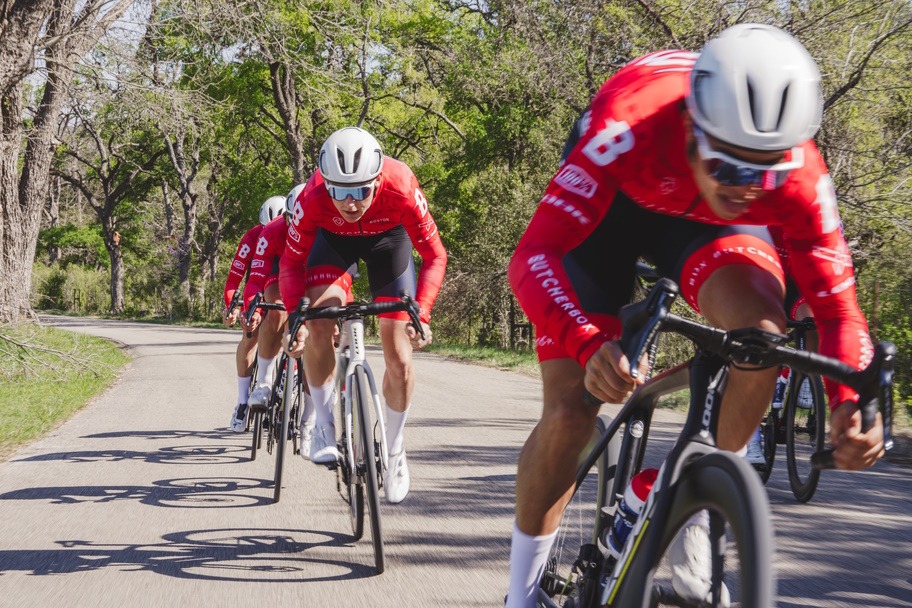
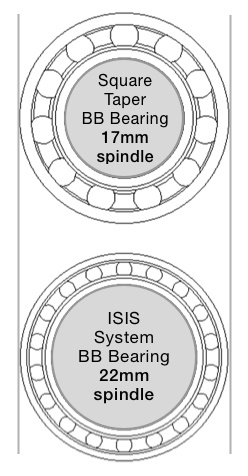
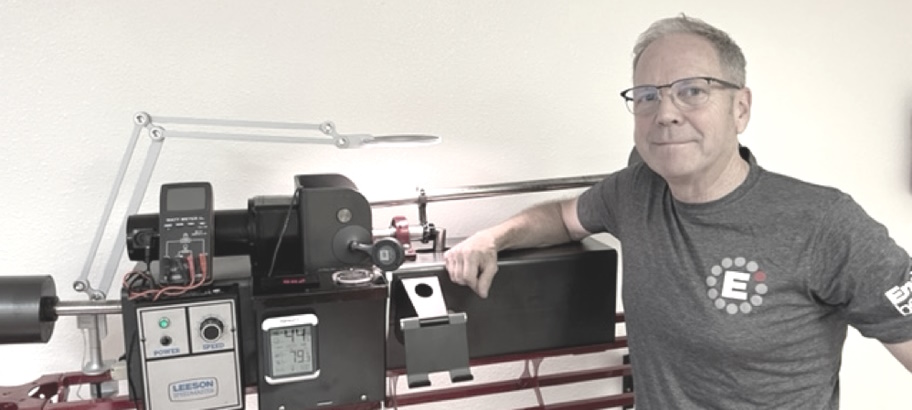
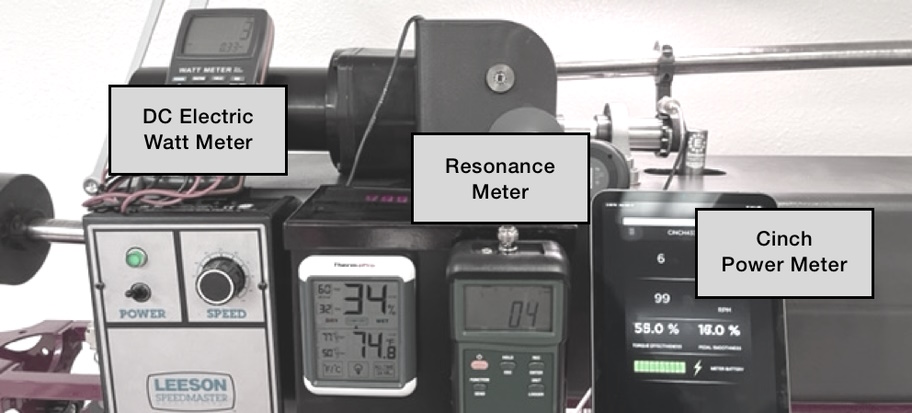

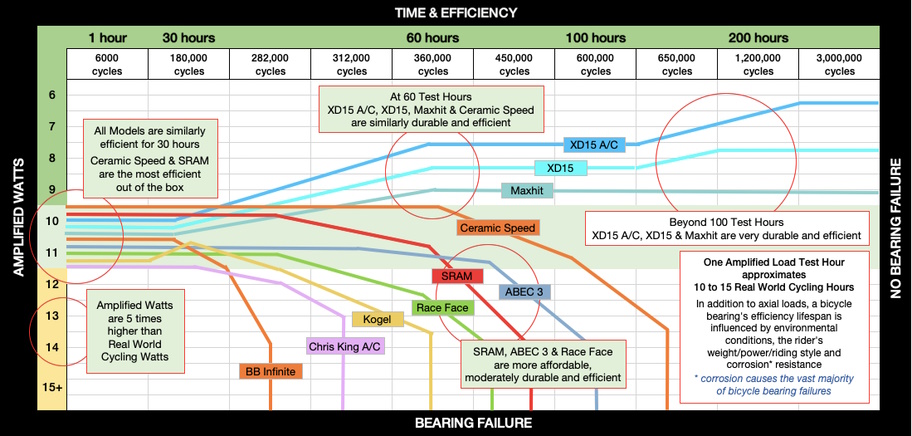
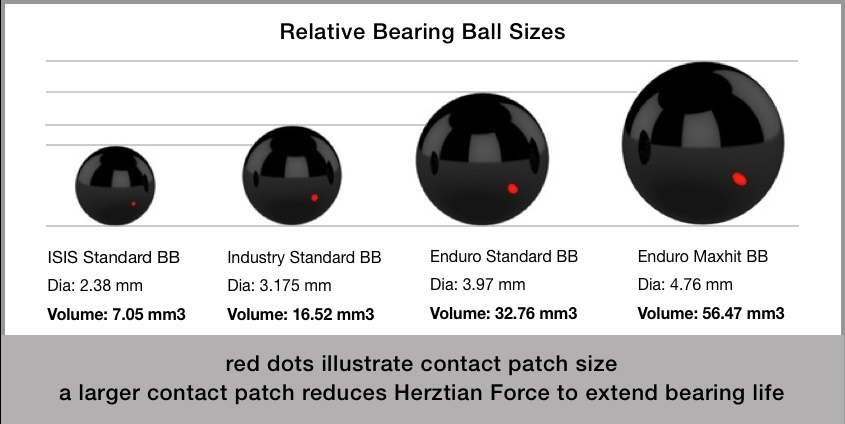
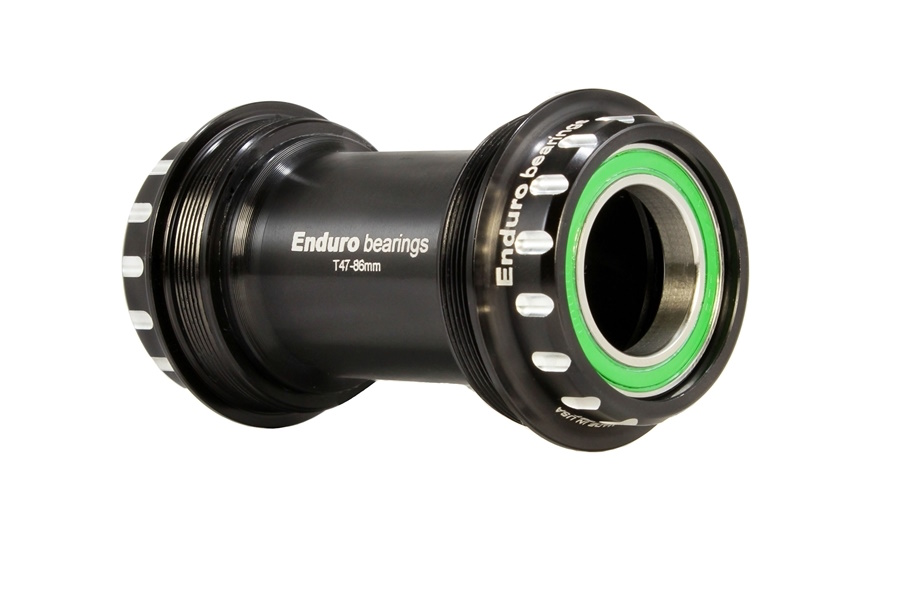

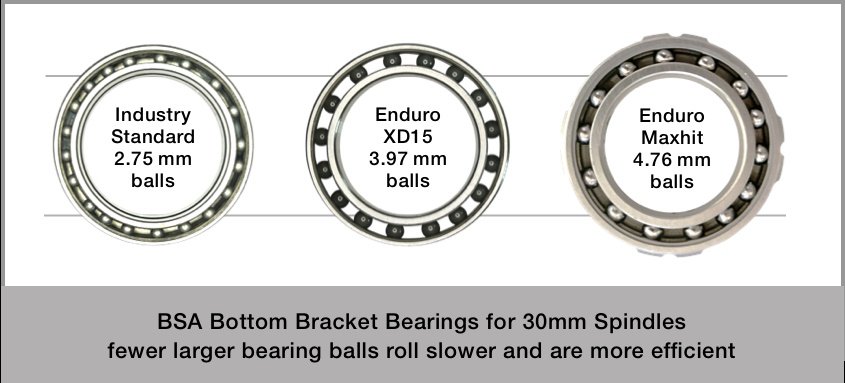
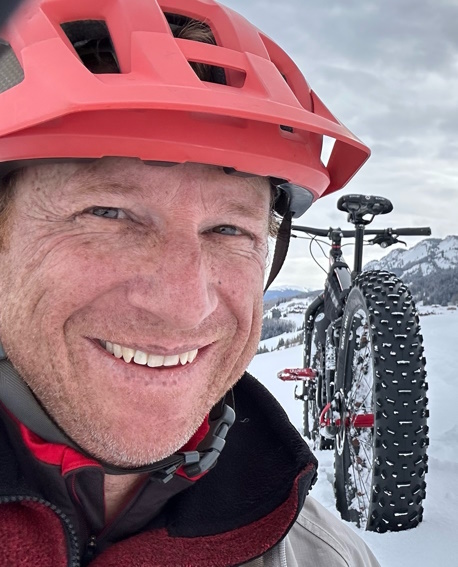





{ 0 comments… add one now }